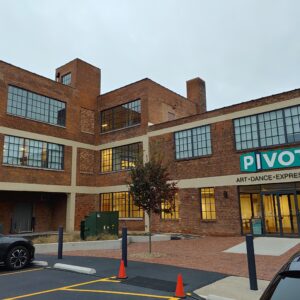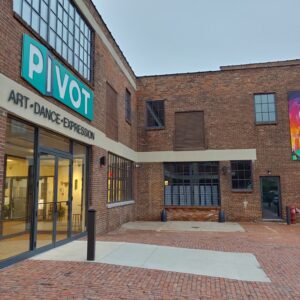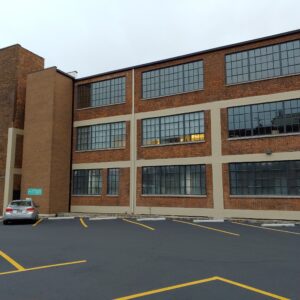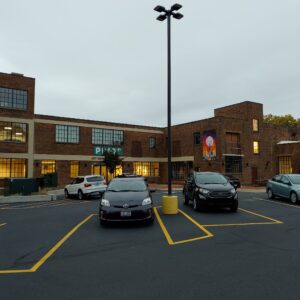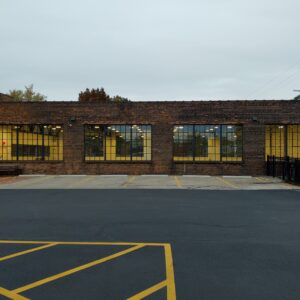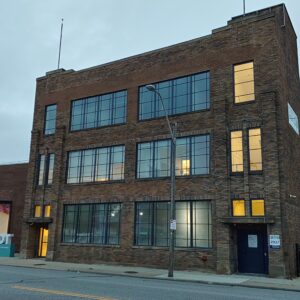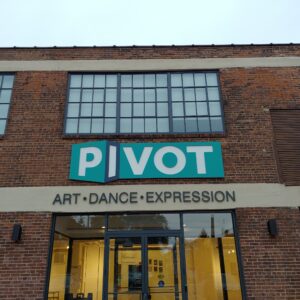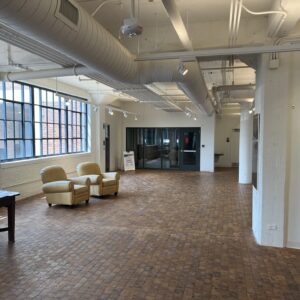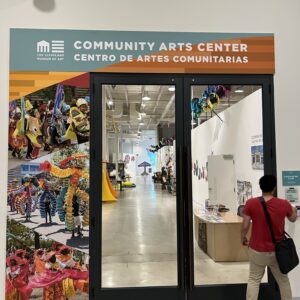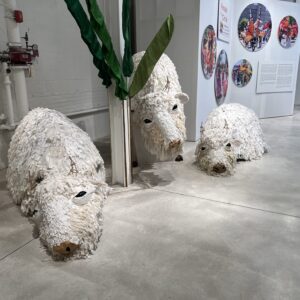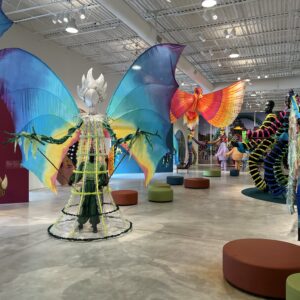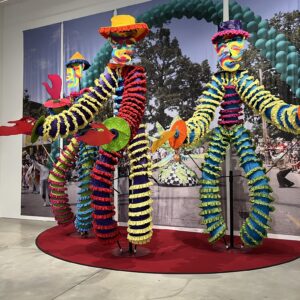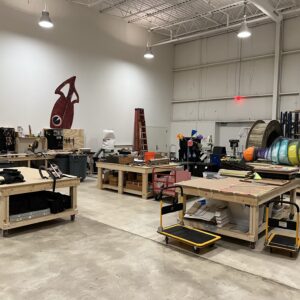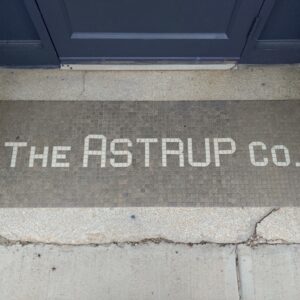In a Nutshell
What: By bringing together arts organizations and community-based nonprofits in a former industrial building transformed into a high-quality community hub, the Pivot Center for Art, Dance, & Expression is helping a community on the west side of Cleveland overcome the trauma of a horrific crime for which the neighborhood became internationally known.
Sector: Arts and Culture, Community Development
Location: Cleveland, OH (Clark-Fulton)
Size: 81,000 square feet
Cost: $14 million
Sources of Funding/Financing: IFF, federal New Markets Tax Credits and Historic Tax Credits, Ohio Historic Tax Credits, City of Cleveland
IFF Support: Three loans totaling $5.3 million closed in December 2019
Design: Studio Lyon/Szot (Joe Smith)
Contract Drawings: City Architecture
General Contractor: Snavely Group
How does a community move forward when it becomes most known for a terrible event? In the Clark-Fulton neighborhood on Cleveland’s west side, one answer is the Pivot Center for Art, Dance, & Expression (Pivot Center) – an 81,000-square-foot industrial facility converted into a hub for nonprofit arts groups and social service organizations that are writing the community’s next chapter.
Opened in July 2021, the Pivot Center is located just steps from a vacant lot where, in 2013, media outlets from around the world flocked after the escape of three young women and one of their daughters from a since demolished house after a decade in captivity. Though the story was one of triumph for the women and their families, the harsh glare of the global media spotlight on Cleveland was hard to overcome.
And in Clark-Fulton, the traumatic incident threatened to permanently overshadow all that was good in the community, including that it’s one of Cleveland’s most ethnically diverse areas; where German, Czech, Italian, Slovak, and Polish roots meld with the neighborhood’s rich Latino culture to create a place bustling with activity that feels very much alive.
For Cleveland native and lifelong resident Rick Foran, the moment was an inflection point.
“I’ve always been an advocate for Cleveland and the revitalization of the city, and so when I saw satellite trucks from all over the world broadcasting for weeks in front of the house, it annoyed me tremendously,” recalls Foran. “I knew we needed to turn proverbial lemons into lemonade by doing something meaningful for the community that would help change the perception of the neighborhood and, by extension, Cleveland.”
“The goal was to create a welcoming, high-quality space for the arts and nonprofits serving the community that would bring people out from behind their closed doors and shuttered windows to enjoy the neighborhood.”
With a career in real estate development spanning 40 years, much of it devoted to preserving historic properties, and a belief in the power of the arts to heal trauma, Foran’s thoughts turned to creating a destination that would draw new visitors to the neighborhood and make a statement about the community’s future.
In the aging former factory for the Astrup Awning Company – a fixture in the neighborhood for almost a century – Foran sensed an opportunity to turn his vision for a new civic anchor into reality. Proactively approaching the Cleveland-based manufacturer, he learned that the company was willing to sell the property at an affordable price. In that moment, Foran’s hypothetical project made the leap to a concrete plan that would ultimately provide 11 organizations with a dynamic facility to support their missions – including one, the Cleveland Family Center for Missing Children and Adults, that serves as a particularly powerful example of how the community hub is helping the neighborhood reframe its story and pivot toward a fresh start.
“Artists are often relegated to second-rate environments because that’s what’s affordable,” says Foran. “But the goal was to create a welcoming, high-quality space for the arts and nonprofits serving the community that would bring people out from behind their closed doors and shuttered windows to enjoy the neighborhood. There’s synergy in bringing diverse organizations together under one roof, and collectively they’re able to help facilitate recovery.”
Creating the Pivot Center
Before community-based organizations could begin using the facility, the former Astrup factory needed a major facelift. After decades of industrial use, followed by several vacant years, there was no shortage of development challenges to convert the space into a functioning community hub. Among the most pressing needs were extensive tuckpointing and brick replacement; new roofs for three of the four buildings that make up the connected complex; the replacement of more than 100 large factory windows; the installation of new electrical, life safety, plumbing, and HVAC systems; and significant environmental remediation.
With seed funding from the Cleveland Foundation, Foran worked with Joe Smith, principal at Studio Lyon/Szot, to define the scope of the project and create an initial design. A Cleveland native now based in New York City, Smith worked on spec for two years as he brought to life Foran’s concept for a space equipped to meet the needs of arts and social services organizations. Beyond structural improvements and the replacement of building systems, plans for the facility called for modifications to the layout of the L-shaped structure to create a centrally located lobby that could double as an exhibition space and the interior buildout of spaces for multiple tenant organizations – all while maintaining the historic character of the complex.
“From a design perspective, we felt it was important to express the original industrial character of the buildings, while simultaneously finding opportunities for strategic interventions that looked forward to the facility’s use as a center for the arts and social support,” says Smith. “We also worked closely with each tenant to help translate their vision for their space into architectural ideas that further their mission within the community.”
To complete the $14 million renovation, Foran assembled a complex capital stack that leveraged federal New Markets Tax Credits; federal and state Historic Tax Credits; tax increment financing (TIF) and a loan through the Vacant Property Initiative from the City of Cleveland; and loans from Cleveland Development Advisors and IFF – which provided $5.3 million in financing for the project via three loans closed in December 2019. With future tenants secured, construction began on the historic rehab in January 2020 with City Architecture serving as the local architect of record and Snavely Group tapped as the general contractor.
“When this was a factory, the property was surrounded by six-foot chain link fences topped with razor wire because of security concerns. Now it’s a welcoming place where people passing by can see what’s going on inside, with the hope that they’ll stop in.”
Within six weeks of kicking off the renovation, however, a challenging development project became exponentially more complicated with the emergence of COVID-19. Overnight, arts organizations’ space needs fundamentally changed, and the philanthropic community shifted gears to offer pandemic relief for the arts rather than funding for capital needs. Amid uncertainty about what the future would hold, several organizations planning to lease space in the Pivot Center pulled out of the project while others reassessed whether their plans for their spaces remained viable. All told, more than 500 change orders were needed during construction to navigate evolving space needs and additional issues uncovered after construction began.
These unexpected hurdles caused a two-year delay in the full completion of the Pivot Center – which opened partially in January 2021 – creating still another challenge as a portion of the lease payments needed to service debt on the property were pushed out further into the future than originally anticipated. During this period, IFF’s portfolio management team stepped in to work with Foran on payment deferrals while the developer sought additional tenants. That effort was successful, with the Pivot Center’s final tenant scheduled to move into their space in the coming weeks.
True to the facility’s history, a number of industrial design features have been preserved, including exposed steel, concrete and wood block floors, and noticeably high ceilings. And by cutting new windows in the facility’s non-historic façade, connectivity was created with the exterior.
“We used original drawings from more than 100 years ago to replicate some of the design elements in the building,” says Foran. “At the same time, we made our own modifications where we could to open the building up to the outside. When this was a factory, the property was surrounded by six-foot chain link fences topped with razor wire because of security concerns. Now it’s a welcoming place where people passing by can see what’s going on inside, with the hope that they’ll stop in.”
High-quality spaces for mission-driven work
In keeping with Foran’s plans, the Pivot Center is now home to a variety of cultural institutions and community-strengthening organizations benefiting from the affordable, high-quality space. Among them are the Cleveland Museum of Art, which operates a 19,500-square-foot community arts center that includes gallery, studio, workshop, and storage space. With plenty of natural light, the center is an airy, welcoming place for museum programming. Among the most striking features in the museum’s section of the Pivot Center are an array of eye-popping costumes and props used in Cleveland’s annual Parade the Circle event – some standing more than 20 feet high. The center is the museum’s only location outside of its century-old Beaux-Arts main facility, making its programming accessible to visitors who don’t regularly visit the main museum.
“For us, the space has provided the opportunity to bring all of our operations under one roof after two decades as a nomadic organization. That’s made us more efficient, while the facility itself has added to our ability to offer an elevated dance experience.”
In the Pivot Center’s southeast corner, Inlet Dance Theatre (Inlet) is occupying a 7,500-square-foot section – the first space in the organization’s 22-year history all its own. In addition to offices and a classroom, Inlet has created a 3,500-square-foot rehearsal and performance space incorporating a specialty floor with a tactile surface overlaid on a sprung wooden floor that provides shock absorption for its dancers. The space can be divided to accommodate multiple classes and rehearsals at a time – making the rehearsal/performance area more flexible.
Inlet’s space in the Pivot Center has also enabled the dance company to lease its rehearsal and performance space to more than 30 other independent dance groups. This has created an important new source of revenue for Inlet while also bolstering Cleveland’s dance community at a time when many arts organizations continue to recover from the pandemic.
“Our space in the Pivot Center has really become a hub for Cleveland’s independent dance community, so much so that we had to hire a new employee to manage all of the rentals,” says Bill Wade, Inlet’s founder and executive/artistic director. “And for us, the space has provided the opportunity to bring all of our operations under one roof after two decades as a nomadic organization. That’s made us more efficient, while the facility itself has added to our ability to offer an elevated dance experience. It’s one of the largest, most beautiful spaces dedicated to dance in Cleveland.”
Elsewhere in the facility:
- A new, 110-seat black box theatre is helping nonprofit LatinUS Theater Co. lean into its mission to promote and produce artistic and theatrical works in Spanish that honor the cultural heritage and traditions of the Latin American population of Northeast Ohio;
- Music lessons, art instruction, dance classes and after-school activities are available to Cleveland youth through the nonprofit Rainey Institute;
- Professional art conservation services are offered by nonprofit ICA Art Conservation;
- Graphic design, digital art, and silk-screening instruction are provided by Future Ink Graphics; and
- Every Angle is operating a full-service creative production studio.
Outside of the arts, the Pivot Center is also home to La Mega Media, the largest Hispanic media platform in Ohio; Cleveland Rape Crisis Center, which provides comprehensive services for survivors of rape, sexual abuse, and sex trafficking; and an office for Cleveland Councilwoman Jasmin Santana, who represents the city’s 14th Ward.
Coming full circle in Clark-Fulton
While each of the organizations now based at the Pivot Center are contributing to the community in their own ways, no tenant better exemplifies the project’s narrative-flipping potential than the volunteer-operated Cleveland Family Center for Missing Children and Adults (Cleveland Family Center). With a mission to offer direct support to families and friends searching for missing loved ones, the nonprofit was co-founded by Gina DeJesus, one of the women who escaped from the house down the street in 2013, and her cousin, Sylvia Colon, who serves as the organization’s executive director.
“We’re here in the Pivot Center doing this work because of Gina,” explains Colon. “Her feeling was that, while something terrible happened on this block, it shouldn’t define the street, the community, and everyone who’s a part of it. It was up to us to help push back against that stigma.”
“While something terrible happened on this block, it shouldn’t define the street, the community, and everyone who’s a part of it. It was up to us to help push back against that stigma.”
Bringing lived experience to the organization’s work in a way few others in the city could, Cleveland Family Center provides whatever support families need in the days, months, and years after their loved one’s disappearance. Examples include designing missing person flyers, maintaining a drumbeat of attention on the case via social media, providing guidance on self-care, and serving as a liaison between families and law enforcement. Last year alone, the organization worked with 58 families, while also facilitating trainings for eight law enforcement agencies. Though Cleveland Family Center’s work is concentrated mostly in northeast Ohio, it’s available as a resource to anyone in need of its services, regardless of their location.
One of the Pivot Center’s longest tenured tenants, Cleveland Family Center began working in the facility prior to renovations. That meant families accessing services often traversed ripped-up floorboards, wires, and other impediments. While that didn’t matter much to DeJesus or Colon, who were happy simply to have a place where they could help families, the 2,500-square-foot space in the Pivot Center has since been transformed with the help of tradespeople who provided $500,000 of in-kind work and American Interiors, which provided high-end furnishings from their showroom displays.
In addition to four private offices, the space includes a fully stocked kitchen/lounge where families can relax and a large open room referred to as the “bullpen” that’s used for meetings and events. Throughout the office, purple accents abound – a nod to DeJesus’ favorite color.
“Our office is very warm and welcoming, because we want the families who come here to feel like it’s a home away from home as they try to navigate situations that are unimaginably disorienting,” says Colon. “It’s also helpful that we’re based in a building that’s focused on the arts, because it doesn’t feel like a basic office building that’s stiff and overwhelming. What’s going on in the building is pretty amazing, and that energy is helpful.”
A catalyst for community reinvention
Walking around the Clark-Fulton neighborhood today, it’s hard to miss the vibrant murals adorning buildings all over the community. It’s also apparent that the veterinary clinic down the street from the Pivot Center is a new addition to the neighborhood. In the near future, a large Hispanic marketplace and resource center will be built in the vicinity too. In many ways, these new community assets are evidence to Foran that the Pivot Center has been successful in helping turn the tide in Clark-Fulton from a story of disinvestment and tragedy into one of redemption and hope.
“It’s great to see all of these positive things happening in the neighborhood, and that residents in the area have reacted positively to the changes,” he concludes. “The Pivot Center was never going to be a moneymaker project, but the reward is in seeing how it’s helped act as a catalyst for the next wave of development and the impact it’s going to create.”
“The Pivot Center was never going to be a moneymaker project, but the reward is in seeing how it’s helped act as a catalyst for the next wave of development and the impact it’s going to create.”
